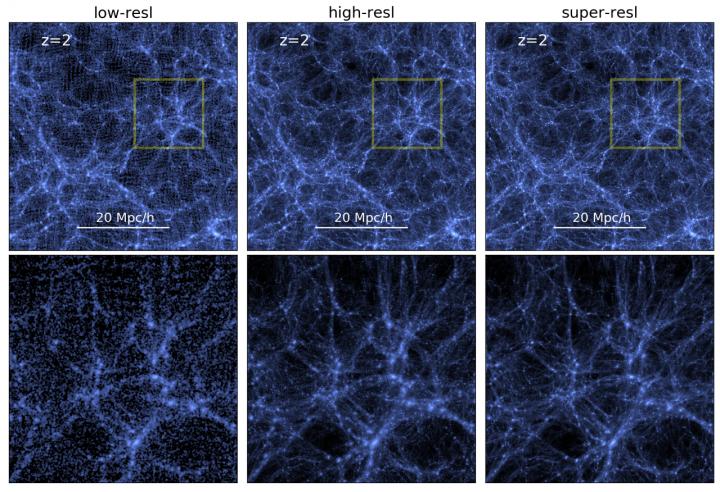National Science Foundation awards compute time on world’s most powerful academic supercomputer to 49 projects

Credit: Tiziana DiMatteo, Carnegie Mellon University
The most powerful supercomputer in the world for academic research has established its mission for the coming year.
The Texas Advanced Computing Center (TACC) announced that the National Science Foundation has approved allocations of supercomputing time on Frontera to 49 science projects for 2020-2021. Time on Frontera is awarded based on a project’s need for very large scale computing to make science and engineering discoveries, and the ability to efficiently use a supercomputer on the scale of Frontera.
The projects selected range from efforts to model the global climate to simulating tornadoes over the lifetime of a storm to designing vehicles for hypersonic flight. The projects are led by researchers at 34 universities across 16 states and began April 1, 2020.
Frontera is a National Science Foundation (NSF)-funded leadership-class computer system designed to be used by the most experienced academic computational scientists in the nation. In 2018, NSF awarded TACC a $60 million grant to design and build the system, and another $60 million to operate the system for five years. Frontera was deployed in September 2019 and since last fall, teams of early users — selected by NSF or granted discretionary access to the system — have successfully used Frontera for science.
“Computation and data-analytics are now an integral part of the scientific discovery workflow for many fields of science and engineering,” said Edward Walker, Program Director in the NSF Office of Advanced Cyberinfrastructure. “The Frontera system, as well as the expert team assembled to support the scientists using the system, serves as an important instrument for the nation. NSF funded Frontera to inspire new transformative ideas and explorations, and to shed light on fundamental scientific discoveries that would not be possible otherwise.”
The allocations awarded this month represent the first cohort of Frontera users selected by the Large Resource Allocation Committee (LRAC) — a peer-review committee of computational science experts convened annually to assess the readiness and appropriateness of projects for time on Frontera.
To be considered for an LRAC allocation, researchers needed to justify the scientific need for the request, and be able to use at least 250,000 node hours (with 56 cores per node) annually, with a maximum award of 5 million node hours per project. Approximately one-third of submitted proposals were awarded time on Frontera.
The projects awarded allocations on Frontera will utilize a total of 54 million node hours. They constitute approximately 65% of the total time on the system being allocated for this year.
An additional 30% of the total time on Frontera will be awarded to “Pathways” projects — smaller allocations to science teams with a strong scientific justification for access to a leadership-class computing resource who have not yet demonstrated code readiness — and “Large-Scale Community Partnerships”– extended allocations of up to three years to support long-lived science and engineering experiments. (Awards for those two tracks will be announced later this month.) A final 5% will be awarded on an as-needed basis to projects of urgent need, educational projects, and industrial collaborations.
“We’re excited by the strength of the applications and the breadth of science that Frontera will support,” said Tommy Minyard, TACC Director of Advanced Computing Systems.
Among the awardees is Ivan Soltesz, a neuroscientist at the Stanford School of Medicine who received an allocation of 1.4 million node hours on Frontera to develop a data-driven, biologically-constrained model of the hippocampal network at scale.
“Our generous allocation of compute time on Frontera makes it possible to perform uniquely large-scale, data-driven simulations of key brain cell networks involved in memory with unprecedented biological realism,” Soltesz said.
Another awardee, Caroline Riedl, research assistant professor of Physics at the University of Illinois, is part of a large international collaboration analyzing particle collision data from the Super Proton Synchrotron at CERN. Riedl was awarded 1.5 million hours to unravel the mass of hadrons and the quark structure of protons. Her work will analyze past particle physics experiments from the COMPASS experiment and explore new detectors for quantum chromodynamics research (COMPASS++/AMBER).
“We were very excited to learn that our request for an LRAC allocation on TACC’s Frontera was approved,” Riedl said. “The Frontera resources will allow us to analyze the data collected with the nuclear physics experiment COMPASS at CERN significantly faster and at greater precision and answer questions like: what holds the world together at its core? And what is the origin of the mass of objects in our daily life?”
Daniel Bodony, Blue Waters Professor in the Department of Aerospace Engineering at the University of Illinois at Urbana-Champaign, will use his allocation of 5 million node hours on Frontera to study fluid-thermal-structure interactions, one of the principal challenges that inhibits hypersonic vehicle design.
“Our allocated time on Frontera will enable us to understand how hypersonic vehicles interact with the very fast, hot, and turbulent flows they generate,” Bodony said. “We are especially interested in predicting and modeling how the vehicle’s external surface responds – deforms and heats-up – to the high-speed flow, as well as how the surface changes impact the flow itself.”
An award of compute time on Frontera will enable Carnegie Mellon Astrophysicist Tiziana DiMatteo to perform cosmological simulations that follow the fate of the universe from the Big Bang all the way to the formation of all galaxies and their massive black holes.
“The novel HPC framework developed for Frontera, driven by CPUs and on-chip neural network accelerators, will allow us to merge generative deep learning with cosmological codes,” DiMatteo said. “AI methods will accelerate cosmological simulations to forge new paths as cosmology moves into the Hyper-Moore regime.”
Frontera is the fifth most powerful supercomputer in the world, the largest at any university, and the fastest non-accelerated (primarily CPU-based) system in the world, according to the latest Top500 list.
“Frontera is an important national resource, helping to accelerate academic research and maintain U.S. technological competitiveness,” said Minyard. “NSF’s investment in cyberinfrastructure, and their trust in TACC to build and operate Frontera, is of paramount importance to the health, security and well-being of our nation.”
###
[View a full list of awarded projects.]
Media Contact
AARON DUBROW
[email protected]
Original Source
https:/




